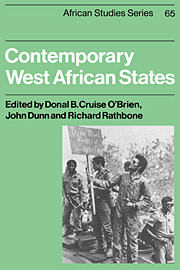3 - Cameroon
Published online by Cambridge University Press: 10 December 2009
Summary
On 4 November 1982 President Ahmadou Ahidjo, head of the executive since 1958, suddenly stepped down in favour of his constitutional successor, Prime Minister Paul Biya. Although on several occasions he had hinted at his intentions not to remain in power forever, and it had been obvious that his health had taken a turn for the worse (his speech and gait often becoming difficult), Ahidjo took both the public and foreign observers by surprise. The transition was nonetheless seen as exemplary and the press did not hesitate to praise it, comparing it to the retirement of President Senghor. Since at this time Cameroon had a growing reputation on the international economic scene, the image of its ‘stability’ and ‘moderation’ thus reached its apotheosis. This was no doubt an ideological and excessive image of Cameroon, just as the one of sudden deterioration would be in turn when difficulties began to accumulate. For on 18 June 1983 an unexpected cabinet reshuffle confirmed what the rumour mill Radio-Trottoir (‘pavement radio’, the popular grapevine), and its white-collar counterpart, Radio-Couloir (‘corridor radio’, the bureaucrat's version), had been murmuring for several months: President Biya dismissed four ‘barons’ of the old regime, Messrs Sadou Daoudou, Eboua, Ayissi Mvodo, and Bwele, and from this moment the rupture between the former president of the republic and his successor was complete. The pace of events began to accelerate. On 22 August, Biya solemnly announced the discovery of a plot against the government.
- Type
- Chapter
- Information
- Contemporary West African States , pp. 31 - 48Publisher: Cambridge University PressPrint publication year: 1990

